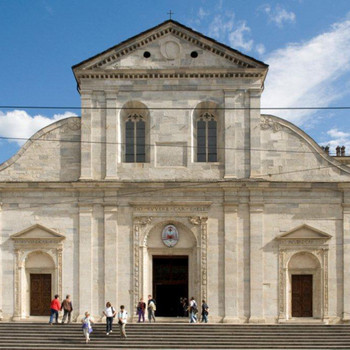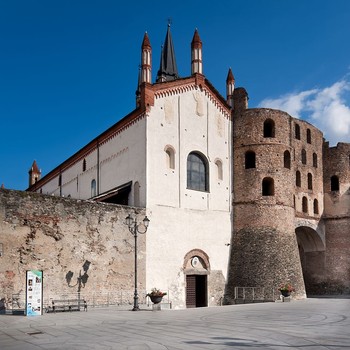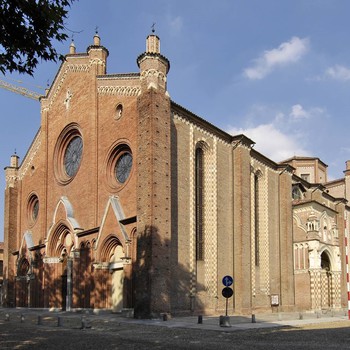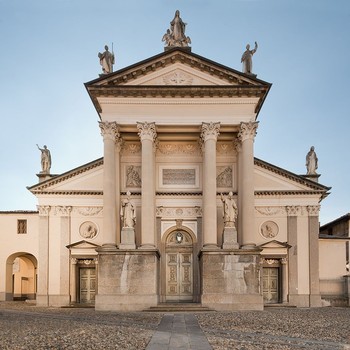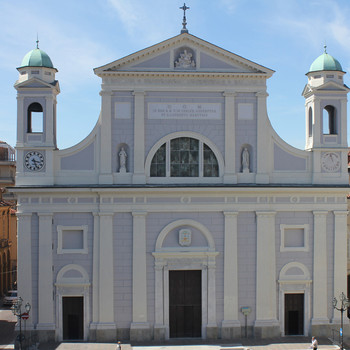Biella Cathedral
Diocesi di Biella ( sec. III; XVIII; XIX )
On 20 March 1402, master mason Giovanni Borri began to rebuild the place of worship over the foundations of the medieval church. It was modified several times, until the construction of the current eclectic façade.
Cathedral of Maria Vergine Assunta
Diocesi di Saluzzo ( sec. XV )
Santa Maria was elevated from a pieve to a collegiate church in 1483, then to cathedral in 1511. It houses the famous polyptych by Hans Clemer, commissioned for the high altar by the Marquises Ludovico II and Margaret of Foix-Candale.
Cathedral of San Donato
Diocesi di Mondovì ( sec. XVIII )
Commenced in 1743 on the earlier Gothic church of San Francesco, the cathedral is the last work of the architect Gallo. The Suffrage Chapel is a gem of Piedmontese Rococo architecture.
Cathedral of San Giovanni Battista
Diocesi di Torino ( sec. IV; XVII )
The Cathedral Church of San Giovanni Battista belongs to the Diocese of Turin. The building has a white marble Renaissance façade and a Latin cross plan, with a nave and two aisles.
Cathedral of San Giovenale
Diocesi di Cuneo-Fossano ( sec. XVIII )
Fossano Cathedral, dedicated to Saint Juvenal, patron of the city, was built in 1771 by the architect Mario Ludovico Quarini, while the bell tower dates back to the previous construction.
Cathedral of San Giusto
Diocesi di Susa ( sec. XI )
Cathedral of San Giusto, Diocese of Susa. Founded in 1027, it was a monastery until 1749, when it became a collegiate church, and then a cathedral in 1772. The building is in Romanesque style, with a Latin cross plan.
Cathedral of San Lorenzo
Diocesi di Alba ( sec. VI; XIX )
The apse area is home to a beautiful wooden choir dated 1512, and the altarpiece with Saint Lawrence, created by painter Claudio Francesco Beaumont in 1766.The cathedral underwent a radical Neogothic restoration in the 19th century.
Cathedral of San Pietro
Diocesi di Alessandria ( sec. XIII; XIX )
The cathedral of San Pietro, in the diocese of Alessandria, is a 19th-century building that replaced an earlier Romanesque church, dating from the 13th century and demolished by order of Napoleon Bonaparte.
Cathedral of Sant'Evasio
Diocesi di Casale Monferrato ( sec. XII; XVIII; XIX )
The current cathedral of Sant’Evasio, with a nave and four aisles, is the result of rebuilding in the style of the second half of the 18th century, while the majestic narthex has preserved its original medieval characteristics.
Cathedral of Santa Maria Assunta
Diocesi di Asti ( sec. VI; XIV )
The Gothic cathedral is the result of three successive rebuilding phases that took place over 700 years. It is made from terracotta and tuff, with bricks alternating with sandstone blocks.
Cathedral of Santa Maria Assunta
Diocesi di Ivrea ( sec. V; X; XIX )
The exterior has a Neoclassical façade, with a nave and two aisles in the interior, closed by an ambulatory.
Cathedral of Santa Maria Assunta
Diocesi di Tortona ( sec. XVI; XIX )
The construction of the church of Santa Maria Assunta e San Lorenzo, the cathedral of the Diocese of Tortona, dates back to the late 16th century, but its current appearance is the result of work in the 19th century.
Cathedrals
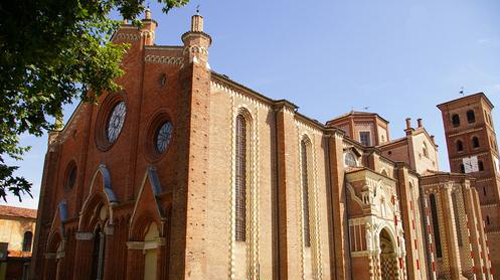
A cathedral is the principal church of a diocese. The name is derived from the bishop’s cathedra, or throne, situated at the end of the apse, behind the altar, so that the ministrant faces the congregation. If the altar is set against the wall, the cathedra is on the Gospel side. A cathedral may be designated metropolitan, primatial or patriarchal, according to the authority of its bishop. Cathedrals are the setting for the most solemn liturgical celebrations, such as ordinations, the chrismal mass on Maundy Thursday, the feasts of particular churches, and the papal masses with apostolic blessing on solemn feast days.






